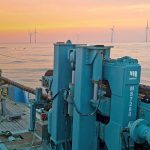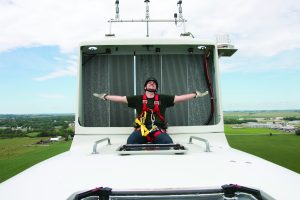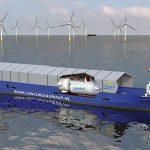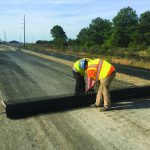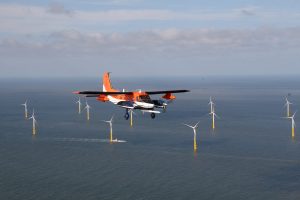The global wind industry is no stranger to seizing opportunity as incentive schemes expire. In key markets, including China and Germany, installation totals ballooned in the months and years before subsidy expirations. The U.S. is no different, and the legislated phase-out of the Production Tax Credit, or PTC, will drive an unprecedented four-year installation total of nearly 40 GW from 2017 to 2020.
In a twist of irony and barring substantial policy changes, the administration of President Donald Trump, a vocal skeptic of wind energy, will oversee the largest four-year rollout of new onshore wind capacity in U.S. history — roughly 5 GW more than was installed from 2009 to 2012 under President Barack Obama’s first term.
A wind market forecast can be broadly spoken of in terms of key drivers and barriers. Drivers supporting MAKE’s outlook include the PTC, wind’s steadily falling levelized cost of energy (LCOE), capacity retirements, state renewable portfolio standards (RPS), and increasing interest from commercial and industrial off-takers (C&I). Key barriers, by contrast, include persistently low natural gas prices, solar power’s falling LCOE, a dearth of transmission availability, and anemic growth in demand for electricity.
The Trump administration itself remains a potent wildcard for the U.S. wind industry. The president is typically hostile to wind in his public statements, but many of his signature policy proposals affect wind in unexpected ways, sometimes benefiting and hindering wind in a single stroke. The case of corporate tax reform illustrates this duality: A sharp reduction in the corporate tax rate, in this case from 35 percent to the 15 percent preferred by the president, would reduce overall tax equity appetite and starve projects of critical funding, but if the reform encourages a broad repatriation of overseas assets, a large pool of firms with a tremendous one-time tax liability could be eager to leverage the PTC to reduce their overall tax burdens.
Policy and Technology
The sense of urgency caused by its looming phase-out is not the only characteristic of the PTC that is driving wind-installation growth. The Internal Revenue Service (IRS) provided a particularly generous guidance for the implementation of this final PTC extension, allowing developers four years to complete projects after initial qualification. This extended run time, well in excess of the typical one- or two-year completion runway in previous iterations of the PTC, mitigates the impact of the de facto cap on the U.S.’ annual installation potential, which is set by the availability of project sites, engineering, procurement and construction (EPC) resources, investor appetite, and manufacturing capacity, among other variables, and allows for roughly 20 GW more wind capacity than a two-year runway would have. Additionally, the market stability engendered by a four-year runway for project installation and a four-year phase-out has created a markedly improved investment climate that would have boosted investor confidence more, but for the post-election uncertainties in tax reform and trade.
The unsubsidized LCOE of onshore wind will continue to decrease, driven by improved turbine technology and increasing rotor diameters. LCOE, as well as the PTC, whose passage through Congress on bipartisan terms in 2015 gives it some much-needed staying power, are generally “fixed” drivers that are not anticipated to react dramatically to likely market or political developments. The scale and pace of non-renewable capacity retirements, state RPS expansions and C&I participation in wind off-take arrangements, on the other hand, are key “variable” drivers that can fluctuate widely based on political and market conditions.
An international uproar over Trump’s decision to step back from the Paris Agreement was echoed in several states, mostly those with Democratic majorities in their state legislatures. Many of these states have existing RPS programs that are nearing the end of their mandates or are modest in aim compared to more recent RPS policies enacted in other states. Amid federal abdication on climate change policy, MAKE anticipates several left-leaning or otherwise environmentally-minded states to increase their RPS mandates substantially in the near-term to provide a counterpoint to the Trump administration while avoiding unnecessary compliance costs by leveraging expiring wind and solar tax credits.
Non-Renewable Retirements
The pace of non-renewable retirements is primarily dependent on plant-level economic decisions, but the administration’s statements and actions carry weight in some circumstances nevertheless. In early 2016, before both the election results and the dimming prospects of Obama’s Clean Power Plan (CPP), more than 80 GW of coal assets were expected to retire before 2026. The apparent demise of the CPP and Trump’s pro-coal policy measures incentivize utilities and IPPs to slow coal retirements. While a promising number of coal retirements have been announced or reaffirmed since November, a substantial percentage of the anticipated retirement capacity will be deferred, especially facilities in Midwestern and Northeastern markets that succeed in winning at capacity auctions.
An increase in the pace of in nuclear retirements will pick up some of this slack in coal retirements. As nuclear facilities increasingly fail to win at those same capacity auctions, states are forced to either heavily subsidize nuclear generation, typically the decision when the state has an RPS or other carbon-reducing aim, or retire them ahead of license expiration. Much of the retired capacity in the PJM and MISO markets will be replaced with new gas-fired capacity, but retirements in New York and New England may translate to substantial demand for new wind capacity, given those states’ commitment to reduce carbon emissions and the severe disparity between wind and nuclear capacity factors.
Synthetic PPAs and the C&I Space
While contract volume from C&I off-takers has not increased as steadily as many in the industry would like, purchasing wind power, particularly through “synthetic PPAs” in markets that allow them, is an increasingly attractive option for companies. Large, power-hungry manufacturers and technology firms such as Google, Apple, and General Motors have signed several off-take deals in the past three years, and this trend is expected to continue throughout the forecast period. Much work remains, however, by utilities and so-called aggregators to court smaller power consumers, who typically desire smaller or syndicated off-take arrangements for shorter terms.
Key Barriers
Among barriers to wind development, a delay in adequate transmission build out looms large. Virtually all outstanding plans for privately financed HVDC lines, which send electricity generated in the central U.S. “wind belt” toward coastal demand centers, are either delayed or have been otherwise scaled back in scope. Delays abound in other transmission projects as well; developers unable to secure off-take agreements due to lack of transmission availability can sign hedge deals to at least build projects before the PTC expiration, but such arrangements may seem disturbingly cavalier to investors in 2019 and 2020 if it becomes apparent transmission will not be able to close the gap and curtailment begins to occur in increasingly congested regions. Burgeoning utility-scale solar markets, especially in highly irradiated Texas, coupled with a drastic reduction in solar LCOE — module costs in the U.S. have fallen more than 40 percent since the start of 2016 — will also increasingly threaten wind’s market share of new capacity additions.
Installation Timelines
The extended four-year project completion runway under the PTC has generally led to two strategies: One, favored by developers and manufacturers on the supply side, involves reaching commercial operations as quickly as possible to mitigate political risk (border adjustment, tax reform, etc.), secure cash-in-hand and, for projects with off-takers, meet pre-established construction timelines.
On the demand-side, three types of off-takers underpin the 2017-2020 boom: Utilities, often acting on state-level RPS mandates; C&I players, especially owners of large and energy-intensive facilities in manufacturing or data storage; and financial entities, who provide hedging arrangements that are popular in deregulated electricity markets with an excellent wind resource, like the Texas Panhandle. These players generally hold to the opposite strategy, scheduling projects in 2019 and 2020 to fully leverage the IRS’ extended installation runway and allow for technology evolution to aid in reducing wind energy’s LCOE while hoping for better power pricing as more legacy generation assets are retired to fulfill mandates or meet expected demand projections. The investment decisions of the demand-side ultimately decide market size, but these players should be careful to consider the risks inherent in delayed project executions.
The Coming Market Recalibration
Installations in 2021 will be subject to the 80 percent PTC value, which keeps wind power competitive in most states, though most developers will avoid intentionally using the lower-value PTC, and utilities complying with RPS requirements are likely to focus on solar investments in 2021, the last year for that technology’s full-value tax credit, which is subject to a similar phase-out to the PTC on a delayed schedule. The 60 percent and 40 percent PTC values erode the economics of new capacity additions, and MAKE does not expect either value to pencil out for most developers, leading to a severe drop in 2022 installations as the U.S. begins a transition to an “economic build” market, dependent upon LCOE competition, except for in a handful of RPS-driven markets.
In this post-PTC environment, the quality of a project’s wind resource will be paramount in achieving the low LCOE required to wrest market share from new solar and natural gas generation. Developers will particularly prize projects in states with abundant land, favorable wind resources, and access to transmission given the impact those project parameters have on LCOE. What were once minor hurdles under the PTC, such as state-level tax policies and permitting difficulties, threaten to become project-killing obstacles in the new marginal environment. In all, onshore wind installations from 2022 to 2026 will number a fraction of the 2017 to 2020 total, almost entirely confined to a handful of states in the center of the country, on land far from the largest U.S. load centers. As a result, regional transmission development, whether through successful private investment or a federal infrastructure policy, will be critical in realizing post-PTC wind power installations.
Threats to Watch
The wind industry must take care to guard against what might be termed myopic oversight, in which individual players or sectors within the wind market are unaware of a threat that appears eminently obvious to other players and sectors, and vice versa. An EPC contractor, for example, may be keenly aware of a coming labor and equipment shortage, and may succeed in communicating this to a developer client, but a small regional utility drafting its integrated resource plan may be completely unaware of the coming disruption. Opportunities for such oversights abound in the next decade of wind development; notable examples include the dangers in tax reform, the lack of EPC resource availability, disruptions to the wind supply chain in the event of a trade action under Trump, and an oversupply of the U.S. electricity market in the face of anemic growth in demand for electricity.
The U.S. market is more dependent on tax equity investment than at any other point in its history, so a decline in investor interest from a sharp drop in the corporate tax rate would have outsize effects on the broader wind market. It must be noted, however, that the threat of tax reform is rapidly receding as Congressional gridlock fails to move healthcare reform legislation to the president’s desk and distracts from meaningful work on taxes. If reform is delayed past 2017, Republicans are unlikely to risk such a major reform package in an election year, meaning a reform package in 2019 would take effect in 2020 and have far less impact on the accelerated depreciation benefits of new wind build. Tax equity providers will continue to be thorough to a fault in due diligence activities; as they grow more confident in these legislative odds, they should be willing to sign off on more projects scheduled for COD in 2018 and 2019.
A labor and equipment shortage is not a purely hypothetical scenario. If projects are pushed into the 2019 and 2020 timeframe en masse, many may well be abandoned as EPC resources fail to cover all desired installations. The previous U.S. installation peak, some 12 GW in 2012, required the import of equipment from Mexico and Canada. In 2020, the Mexican market alone will be larger than the combined Mexican and Canadian markets of 2012. Compounding the shortage, new installations will vie for resources with a partial-scope repowering drive aimed at extending the PTC eligibility of roughly 7 GW of existing wind farms.
The threat of a border adjustment provision in the U.S. tax code follows the fortunes of broader tax reform, but a tariff action remains a real concern: Trump has shown a pointed willingness to use trade as a negotiating tool, particularly with China over its handling of North Korea and with Mexico over his border wall proposals. Either trade action would destabilize a domestic supply chain that has grown increasingly reliant on turbine components sourced from abroad given continued price pressure and PTC instability that resulted in a series of factory closures in 2013 and 2014.
The final oversight affects the post-2020 market: If coal-fired facility operators are particularly loath to retire assets and new natural gas installations do not slow from the 8 GW annual average of the past six years, the subsidized installation booms of both wind and solar power from 2017 to 2021 will substantially oversupply the U.S. market and collapse demand in the later years of the forecast for all utility-scale generation sources, including wind.
Plenty of Opportunity
Ultimately, the 10-year outlook highlights yet another boom-and-bust cycle for the U.S. wind industry. Still, the boom, unprecedented in scale, offers plenty of potential. The supply side is working furiously: More than enough equipment to cover the four-year outlook qualified for the full-value PTC through safe harboring turbines and turbine components; interconnection queues across the country are bloated, and developers are hunting for high-quality projects. If demand materializes, and supply is not jeopardized by external disruptions, this market looks set to make the most of a loud boom.

















